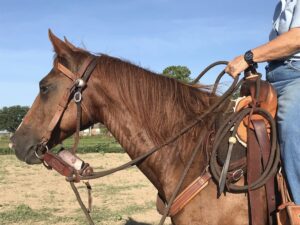Your cart is currently empty!
Cueing Your Horse to Relax
Sometimes, just before I show, I get nervous. As I was leaving the arena after my first time showing a cutting horse, I couldn’t have told you the color of the 3 cows I had just worked. Sound familiar? One of the best and worst things that you can say about horses is that they pretty readily pick up on our emotions. If you take into account horses that aren’t yet show veterans/babysitters, and add a nervous rider to the mix, you have the scientific formula for the donation of entry fees.
NervousRider + NervousHorse = DonationΣntryFee(Time + Expenses)²
Wouldn’t it be helpful if we could actually cue our horse to relax? I’m not sure how to go here without discussing a little bit of the science and psychology behind animal behavior manipulation. Don’t start yawning just yet though. You probably know more about this than you realize. Think back to high school, or Psych 101, to a Russian scientist named Ivan Pavlov. He accidentally discovered what is now called Classical Conditioning. Does that ring a bell?
Pavlov was a physiologist who was studying salivation in dogs. To summarize his simple, yet groundbreaking find, his lab techs would enter a door that had a bell (some say it was a buzzer) attached to it when going in to feed the dogs. The dogs began to associate the bell with food so strongly that they would begin to salivate at just the sound of the bell. Ding! The fully developed association of the bell elicited the identical response as food. Biochemically and neurologically, the two different stimuli became the same thing to the dog. The bell was a formerly neutral stimulus and the food is the unconditioned stimulus until they were associated. Then the bell effectively became the same thing as the food, or what we’d now call a conditioned stimulus. When we get the dog respond to the bell by salivating, in behavioral terms we’ve gotten a conditioned response to a conditioned stimulus. It sounds more complicated than it really is. The point is, do not underestimate the power these simple types of associations can have, for better or for worse.
A couple of big picture facets here are really important to note. First of all, salivation is involuntary. You don’t have to be taught to salivate when food arrives. That’s an unconditioned response to an unconditioned stimulus. You also can’t naturally make yourself salivate like you can make yourself move your arm, unless you are descended from carnival folk. Involuntary crying when overcome with emotion, turning it up when “Sweet Home Alabama” plays, and panicking when you feel your wife’s hands on your bare back (she’s just spotted a pimple) are all under the same umbrella. Ding!
Secondly, these associations can be very powerful and last practically forever. Think of that certain smell that takes you back to your grandma’s kitchen. Most horses with phobias of trailer loading, those who sit back automatically when being tied, or others who routinely buck when saddled have these bad “habits” due to the mechanism of association or what I like to call Accidental Classical Konditioning or A.C.K! (“Ack!” T-shirts, coffee mugs, and calming supplements soon to be for sale on our website).
I’ll bet that most of your moms used a special trick when potty training you. They’d take you to the potty and turn on the faucet, using the sound of running water to help you go. Classically Conditioned thanks to mom’s lack of patience, now, you can’t walk past a fountain without having to pee. Ding!

Wielding this new understanding of a powerful tool and making your horse relax is simple. It does require discipline and consistency on your part, however. During every ride, there should be moments when you allow your horse to simply stand still and mentally soak on something good that they’ve just done. These are the times when your horse is likely going to lick and chew, lower their head, and/or take a big deep breathe. Those are relaxation/calming signals. These breaks should allow the horse to stand and rest for at least 30 seconds. I’d simply suggest that when you know these moments are about to happen (and a huge part of being a good horseman is regularly orchestrating them) make sure to pitch your horse lots of slack, hold the reins in just one hand, and put that hand all the way down on your horse’s neck. Touch the neck, purposefully, and without fail. You are now associating a cue with the time to relax. Ding!
Done consistently and with proper timing, your horse will quickly begin to recognize these breaks and appreciate the opportunity. Over time, they will become like a statue when they feel that slack and hand position. Once that is done you systematically start doing it in more and more challenging, but controlled situations. The relaxation becomes irresistible. Their confidence will grow significantly too. Ding!

It isn’t that complicated after all, is it? I would compare sitting with the reins held up, to being at a red light with your foot on the brake. It is still a state of attentiveness. However, putting your hand down is like putting your truck in Park. Ding! As an added benefit, they’ll feel the change when you pick your hand back up and put them back in gear. Congrats! You’re practically ready to train horses for the Budweiser commercials now!
by
Tags:

Leave a Reply
You must be logged in to post a comment.